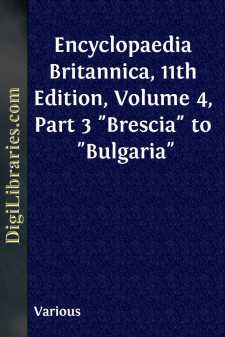Categories
- Antiques & Collectibles 13
- Architecture 36
- Art 48
- Bibles 22
- Biography & Autobiography 813
- Body, Mind & Spirit 142
- Business & Economics 28
- Children's Books 15
- Children's Fiction 12
- Computers 4
- Cooking 94
- Crafts & Hobbies 4
- Drama 346
- Education 46
- Family & Relationships 57
- Fiction 11829
- Games 19
- Gardening 17
- Health & Fitness 34
- History 1377
- House & Home 1
- Humor 147
- Juvenile Fiction 1873
- Juvenile Nonfiction 202
- Language Arts & Disciplines 88
- Law 16
- Literary Collections 686
- Literary Criticism 179
- Mathematics 13
- Medical 41
- Music 40
- Nature 179
- Non-Classifiable 1768
- Performing Arts 7
- Periodicals 1453
- Philosophy 64
- Photography 2
- Poetry 896
- Political Science 203
- Psychology 42
- Reference 154
- Religion 513
- Science 126
- Self-Help 84
- Social Science 81
- Sports & Recreation 34
- Study Aids 3
- Technology & Engineering 59
- Transportation 23
- Travel 463
- True Crime 29
Encyclopaedia Britannica, 11th Edition, Volume 4, Part 3 "Brescia" to "Bulgaria"
by: Various
Categories:
Description:
Excerpt
BRESCIA (anc. Brixia), a city and episcopal see of Lombardy, Italy, the capital of the province of Brescia, finely situated at the foot of the Alps, 52 m. E. of Milan and 40 m. W. of Verona by rail. Pop. (1901) town, 42,495; commune, 72,731. The plan of the city is rectangular, and the streets intersect at right angles, a peculiarity handed down from Roman times, though the area enclosed by the medieval walls is larger than that of the Roman town, which occupied the eastern portion of the present one. The Piazza del Museo marks the site of the forum, and the museum on its north side is ensconced in a Corinthian temple with three cellae, by some attributed to Hercules, but more probably the Capitolium of the city, erected by Vespasian in A.D. 73 (if the inscription really belongs to the building; cf. Th. Mommsen in Corp. Inscrip. Lat. v. No. 4312, Berlin, 1872), and excavated in 1823. It contains a famous bronze statue of Victory, found in 1826. Scanty remains of a building on the south side of the forum, called the curia, but which may be a basilica, and of the theatre, on the east of the temple, still exist.
Brescia contains many interesting medieval buildings. The castle, at the north-east angle of the town, commands a fine view. It is now a military prison. The old cathedral is a round domed structure of the 10th (?) century erected over an early Christian basilica, which has forty-two ancient columns; and the Broletto, adjoining the new cathedral (a building of 1604) on the north, is a massive building of the 12th and 13th centuries (the original town hall, now the prefecture and law courts), with a lofty tower. There are also remains of the convent of S. Salvatore, founded by Desiderius, king of Lombardy, including three churches, two of which now contain the fine medieval museum, which possesses good ivories. The church of S. Francesco has a Gothic façade and cloisters. There are also some good Renaissance palaces and other buildings, including the Municipio, begun in 1492 and completed by Jacopo Sansovino in 1554-1574. This is a magnificent structure, with fine ornamentation. The church of S. Maria dei Miracoli (1488-1523) is also noteworthy for its general effect and for the richness of its details, especially of the reliefs on the façade. Many other churches, and the picture gallery (Galleria Martinengo), contain fine works of the painters of the Brescian school, Alessandro Bonvicino (generally known as Moretto), Girolamo Romanino and Moretto's pupil, Giovanni Battista Moroni. The Biblioteca Queriniana contains early MSS., a 14th-century MS. of Dante, &c., and some rare incunabula. The city is well supplied with water, and has no less than seventy-two public fountains. Brescia has considerable factories of iron ware, particularly fire-arms and weapons (one of the government small arms factories being situated here), also of woollens, linens and silks, matches, candles, &c. The stone quarries of Mazzano, 8 m. east of Brescia, supplied material for the monument to Victor Emmanuel II....












